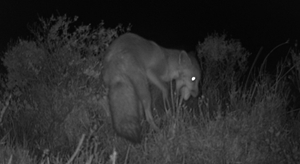By Elli Rivers, PhD Student
This is the second year of my PhD study of nest and chick survival of curlew in the New Forest. This season GWCT Head of Predation Control Studies Mike Short and I found a total of 28 curlew nests (approximately half of the pairs in the New Forest), compared with 23 last year.
It’s not long since Midsummer’s day and, unexpectedly, we have only one curlew nest left with a camera. This is a significant change from last year when, as a result of repeated early nest predations, many birds had laid again and were still on the nest at this stage in the breeding season. Across the Forest, targeted predator management by the Forestry England keeper team has been intensified since the spring and first nesting attempts have been successful, with multiple broods hatching around the same time in mid-May.
Lapwing productivity has also been excellent, and at the time of writing, more fledged lapwing chicks can be seen foraging around Forest ponds and wet flushes than have been for many years – a lovely sight. In total we set 24 trail cameras on curlew nests and 43 on lapwing nests, enabling us to gather a great quantity of relevant data on wader nest survival.
Unfortunately, due to delays in licensing, we have so far been unable to deploy radio tags on curlew chicks as planned, but happily we have been able to tag a small sample of lapwing chicks across several different management areas. This gives us an opportunity to both test the technology in complex New Forest habitats and to better begin to understand the survival rates of these birds in a challenging environment.
In addition, we have successfully deployed five more GPS tags on adult female curlews, which upload data on the birds’ hourly positions every 48 hours. This gives an unprecedented level of detail and will greatly improve the ease of nest-finding next breeding season.
 Our initial review of the nest camera data has shown that, yet again, foxes have been the main nest predator of curlew, and fox culling and sighting records across the Forest indicate surprisingly high local densities. In fact, all curlew nest predations recorded on camera this season have been attributed to foxes, bar one nest lost to carrion crow and another to a domestic dog. For lapwing, we have also recorded nest predation events by badger and raven.
Our initial review of the nest camera data has shown that, yet again, foxes have been the main nest predator of curlew, and fox culling and sighting records across the Forest indicate surprisingly high local densities. In fact, all curlew nest predations recorded on camera this season have been attributed to foxes, bar one nest lost to carrion crow and another to a domestic dog. For lapwing, we have also recorded nest predation events by badger and raven.
Beyond the marked increases in curlew nest survival, one of the most encouraging things we have witnessed this season is the excellent teamwork between Forestry England, the National Parks Authority and the GWCT, all with a shared goal of improving wader productivity in the New Forest. We are looking forward to sharing information about the project with the local community on our stand at the New Forest Show, 26-28 July. We hope to see you there!